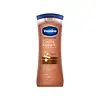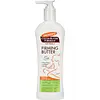What's inside
What's inside
 Key Ingredients
Key Ingredients

No key ingredients
 Benefits
Benefits

 Concerns
Concerns

 Ingredients Side-by-side
Ingredients Side-by-side

Water
Skin ConditioningGlycerin
HumectantPetrolatum
EmollientStearic Acid
CleansingDimethicone
EmollientButylene Glycol
HumectantGlycol Stearate
EmollientPEG-100 Stearate
Isopropyl Myristate
EmollientHelianthus Annuus Seed Oil
EmollientCocos Nucifera Oil
MaskingGlyceryl Stearate
EmollientTheobroma Cacao Seed Butter
EmollientPhenoxyethanol
PreservativeCetyl Alcohol
EmollientMagnesium Aluminum Silicate
AbsorbentParfum
MaskingMethylparaben
PreservativeHydroxyethylcellulose
Emulsion StabilisingXanthan Gum
EmulsifyingPropylparaben
PreservativeDisodium EDTA
Stearamide Amp
Coumarin
PerfumingGeraniol
PerfumingHexyl Cinnamal
PerfumingHydroxycitronellal
PerfumingLimonene
PerfumingLinalool
PerfumingCaramel
Cosmetic ColorantWater, Glycerin, Petrolatum, Stearic Acid, Dimethicone, Butylene Glycol, Glycol Stearate, PEG-100 Stearate, Isopropyl Myristate, Helianthus Annuus Seed Oil, Cocos Nucifera Oil, Glyceryl Stearate, Theobroma Cacao Seed Butter, Phenoxyethanol, Cetyl Alcohol, Magnesium Aluminum Silicate, Parfum, Methylparaben, Hydroxyethylcellulose, Xanthan Gum, Propylparaben, Disodium EDTA, Stearamide Amp, Coumarin, Geraniol, Hexyl Cinnamal, Hydroxycitronellal, Limonene, Linalool, Caramel
Water
Skin ConditioningParaffinum Liquidum
EmollientTheobroma Cacao Extract
Skin ConditioningIsopropyl Myristate
EmollientPropylene Glycol
HumectantCetyl Alcohol
EmollientPalmitic Acid
EmollientStearic Acid
CleansingTheobroma Cacao Seed Butter
EmollientButyrospermum Parkii Butter
Skin ConditioningTocopherol
AntioxidantCocoyl Hydrolyzed Collagen
CleansingHydrolyzed Elastin
EmollientGlycerin
HumectantCamellia Oleifera Seed Extract
AstringentChamomilla Recutita Flower Extract
MaskingPanax Ginseng Root Extract
EmollientUbiquinone
AntioxidantDimethicone
EmollientLecithin
EmollientCarnitine
CleansingHelianthus Annuus Seed Oil
EmollientLeuconostoc/Radish Root Ferment Filtrate
AntimicrobialPolyimide-1
Triethanolamine
BufferingPEG-40 Stearate
EmulsifyingStearyl Alcohol
EmollientCarbomer
Emulsion StabilisingEthylhexylglycerin
Skin ConditioningTetrasodium EDTA
Acrylates Copolymer
Phenoxyethanol
PreservativeButylene Glycol
HumectantParfum
MaskingBenzyl Benzoate
AntimicrobialBenzyl Cinnamate
PerfumingWater, Paraffinum Liquidum, Theobroma Cacao Extract, Isopropyl Myristate, Propylene Glycol, Cetyl Alcohol, Palmitic Acid, Stearic Acid, Theobroma Cacao Seed Butter, Butyrospermum Parkii Butter, Tocopherol, Cocoyl Hydrolyzed Collagen, Hydrolyzed Elastin, Glycerin, Camellia Oleifera Seed Extract, Chamomilla Recutita Flower Extract, Panax Ginseng Root Extract, Ubiquinone, Dimethicone, Lecithin, Carnitine, Helianthus Annuus Seed Oil, Leuconostoc/Radish Root Ferment Filtrate, Polyimide-1, Triethanolamine, PEG-40 Stearate, Stearyl Alcohol, Carbomer, Ethylhexylglycerin, Tetrasodium EDTA, Acrylates Copolymer, Phenoxyethanol, Butylene Glycol, Parfum, Benzyl Benzoate, Benzyl Cinnamate
 Reviews
Reviews

Ingredients Explained
These ingredients are found in both products.
Ingredients higher up in an ingredient list are typically present in a larger amount.
Butylene Glycol (or BG) is used within cosmetic products for a few different reasons:
Overall, Butylene Glycol is a safe and well-rounded ingredient that works well with other ingredients.
Though this ingredient works well with most skin types, some people with sensitive skin may experience a reaction such as allergic rashes, closed comedones, or itchiness.
Learn more about Butylene GlycolCetyl Alcohol is a fatty alcohol. Fatty Alcohols are most often used as an emollient or to thicken a product.
Its main roles are:
Though it has "alcohol" in the name, it is not related to denatured alcohol or ethyl alcohol.
The FDA allows products labeled "alcohol-free" to have fatty alcohols.
Learn more about Cetyl AlcoholDimethicone is a type of synthetic silicone created from natural materials such as quartz.
What it does:
Dimethicone comes in different viscosities:
Depending on the viscosity, dimethicone has different properties.
Ingredients lists don't always show which type is used, so we recommend reaching out to the brand if you have questions about the viscosity.
This ingredient is unlikely to cause irritation because it does not get absorbed into skin. However, people with silicone allergies should be careful about using this ingredient.
Note: Dimethicone may contribute to pilling. This is because it is not oil or water soluble, so pilling may occur when layered with products. When mixed with heavy oils in a formula, the outcome is also quite greasy.
Learn more about DimethiconeGlycerin is already naturally found in your skin. It helps moisturize and protect your skin.
A study from 2016 found glycerin to be more effective as a humectant than AHAs and hyaluronic acid.
As a humectant, it helps the skin stay hydrated by pulling moisture to your skin. The low molecular weight of glycerin allows it to pull moisture into the deeper layers of your skin.
Hydrated skin improves your skin barrier; Your skin barrier helps protect against irritants and bacteria.
Glycerin has also been found to have antimicrobial and antiviral properties. Due to these properties, glycerin is often used in wound and burn treatments.
In cosmetics, glycerin is usually derived from plants such as soybean or palm. However, it can also be sourced from animals, such as tallow or animal fat.
This ingredient is organic, colorless, odorless, and non-toxic.
Glycerin is the name for this ingredient in American English. British English uses Glycerol/Glycerine.
Learn more about GlycerinHelianthus Annuus Seed Oil is the oil derived from the seeds of a Sunflower. Sunflower seed oil is non-fragrant. It is an emollient, meaning it helps to soften the skin.
Sunflower seed oil contains many fatty acids. The fatty acids found in sunflower seeds include (from highest amount to least): linoleic acid, myristic acid, palmitic acid, stearic acid, arachidic acid, oleic acid, and linolenic acid.
These fatty acids help the skin create ceramides. Ceramides play a role in repairing the skin barrier.
Helianthus Annuus Seed Oil helps moisturize the skin. This in turn helps the skin look more rejuvenated and smoother.
Sunflowers are rich in vitamin E.
Historians believe Indigenous cultures of North America domesticated sunflowers before corn. Thus they relied on sunflower oil for a variety of uses. One such use is moisturizing skin and hair.
Sunflower seed oil may not be fungal acne safe. We recommend speaking with a professional if you have any concerns.
Learn more about Helianthus Annuus Seed OilIsopropyl Myristate is an emollient, thickening agent, and texture enhancer. It is created from isopropyl alcohol and myristic acid.
It is used to help other ingredients be better absorbed. It is also an emollient and may help soften and hydrate the skin.
The comedogenic rating of this ingredient depends on the concentration. Lower amounts results in a lower rating.
Isopropyl Myristate may not be fungal acne safe. It can potentially worsen acne prone skin.
Learn more about Isopropyl MyristateParfum is a catch-all term for an ingredient or more that is used to give a scent to products.
Also called "fragrance", this ingredient can be a blend of hundreds of chemicals or plant oils. This means every product with "fragrance" or "parfum" in the ingredients list is a different mixture.
For instance, Habanolide is a proprietary trade name for a specific aroma chemical. When used as a fragrance ingredient in cosmetics, most aroma chemicals fall under the broad labeling category of “FRAGRANCE” or “PARFUM” according to EU and US regulations.
The term 'parfum' or 'fragrance' is not regulated in many countries. In many cases, it is up to the brand to define this term.
For instance, many brands choose to label themselves as "fragrance-free" because they are not using synthetic fragrances. However, their products may still contain ingredients such as essential oils that are considered a fragrance by INCI standards.
One example is Calendula flower extract. Calendula is an essential oil that still imparts a scent or 'fragrance'.
Depending on the blend, the ingredients in the mixture can cause allergies and sensitivities on the skin. Some ingredients that are known EU allergens include linalool and citronellol.
Parfum can also be used to mask or cover an unpleasant scent.
The bottom line is: not all fragrances/parfum/ingredients are created equally. If you are worried about fragrances, we recommend taking a closer look at an ingredient. And of course, we always recommend speaking with a professional.
Learn more about ParfumPhenoxyethanol is a preservative that has germicide, antimicrobial, and aromatic properties. Studies show that phenoxyethanol can prevent microbial growth. By itself, it has a scent that is similar to that of a rose.
It's often used in formulations along with Caprylyl Glycol to preserve the shelf life of products.
Stearic Acid is a fatty acid. It is an emollient, emulsifier, and texture enhancer.
As an emollient, stearic acid helps soften skin. It aids the skin's protective barrier by preventing water loss. It also provides a gentle cleansing effect without stripping away natural oils.
Stearic acid may also be used to enhance the texture of products. It can add volume and stabilize ingredients such as water and oil. This can help water and oil ingredients from separating.
Sources of stearic acid include animal or vegetable fats/oils such as coconut or shea. It can be naturally found in butter, cocoa butter, shea butter, vegetable fats, and animal tallow.
This ingredient may not be Malassezia folliculitis, or fungal-acne safe.
Learn more about Stearic AcidTheobroma Cacao Seed Butter comes from the Theobroma cacoa, or Cacao tree. Cacao trees are native to tropical landscapes.
Like other plant butters, Cacao seed butter is an emollient. Emollients help soothe and soften your skin. By creating a barrier to trap moisture in, emollients help keep your skin hydrated.
Cacao seed butter contains antioxidants known as polyphenols. Antioxidants help fight free-radical molecules by stabilizing them. Unstable free-radicals may cause damage to your skin cells. Antioxidants may help with anti-aging.
Theobroma Cacao Seed Butter can be bad for acne prone skin.
Learn more about Theobroma Cacao Seed ButterWater. It's the most common cosmetic ingredient of all. You'll usually see it at the top of ingredient lists, meaning that it makes up the largest part of the product.
So why is it so popular? Water most often acts as a solvent - this means that it helps dissolve other ingredients into the formulation.
You'll also recognize water as that liquid we all need to stay alive. If you see this, drink a glass of water. Stay hydrated!
Learn more about Water